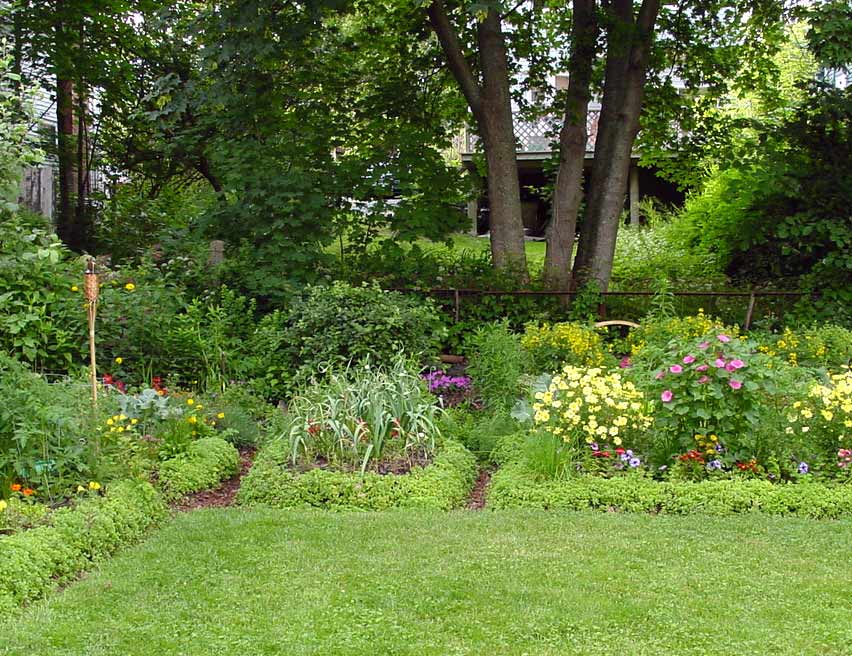 Building up the raised beds Most of this area was grass initially; I had one garden bed and wanted to expand it. In the fall of '93 (as I recall), the sod was cut, shaken to release as much of the soil as possible, and the residual sod put in a large pile to decompose. The beds were marked out with alleys about 60 cm (2 ft) wide between them and a wider alley, about 2 meters, behind them where it was strongly shaded. The alleys were dug down to about 30 cm (1 ft ), well into the subsoil, and the soil put on the beds. I collected 150+ bags of leaves from the curbside and put the leaves in the excavated alleys; I walked the alleys repeatedly to compress the leaves, especially after rains, and added more leaves as needed to bring the surface up to about lawn level. In subsequent falls, I repeated this process. For the first few years most of the material I dug out of the alleys in the fall still included a lot of partially decomposed leaves and needed more time to make good compost. I put most of it in a corner of the yard and grow squashes on top of this coarse compost the next summer. By the fall (2 years after I collected the leaves that were in the pile), this material was well composted and I either added it directly to the beds or put it in storage bins for later use. With each year, the composting process in the alleys speeded up and I started to put most of it directly on top of the beds in the fall or into storage bins. This material is quite "chunky", with clumps of of soil and darkened, partially decomposed leaves; or it is "flaky" if there is less soil in it. The chunks and flaskes provide protection from the direct impact of rain on open soil over the winter. (Otherwise, the rain smears the soil surface and plugs up soil pores which are important for water infiltration and for good soil structure.) I also use a light cover of leaves to protect the soil in some areas over winter, and around plants in summer.) The rain and freeze-thaw cycles help to break up the chunks or flakes and they are largely broken down by spring; sometimes I rake the residual coarse material off of the beds into the alleys. In areas that I don't dig up every year, the leaves are well composted with no recognizable remains after 2 years. This is a 'cold' composting process. It seems to proceed much faster in the trenches than when leaves are put in a pile on top of the soil, probably because the leaves remain moist through the summer and Red Wiggler and other worm populations build up very quickly in the summer after leaves are placed in the alleys. Because there are no weed seeds in the leaves, the fact that the composting process doesn't go through a high temperature stage (and kill the weed seeds) is not of concern. The initial beds were elevated only a few centimeters above the lawn. The beds are now elevated about 25 to 40 cm (10-15 inches) and I have gradually increased the area in beds. The alleys became somewhat narrower as the beds increased in elevation. The leafy alleys are nice to walk on, and give the garden an orderly appearance even when it's "a jungle" in the beds! Now that I have got the beds built up, there is really too much compost being produced. To slow it down, also to reduce the nutrient imports and save some of leaf collecting effort, I sometimes fill up most of an excavated alley with layers of cardboard and/or newspapers, and then put about 5 cm of leaves on top. The cardboard and papers decompose more slowly than leaves, but even so, they are largely unrecognizable after 3-4 years. (I even put old receipts and discarded personal documents in the excavated alleys as a way of getting rid of them!) |